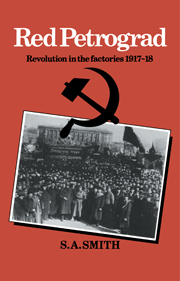Book contents
- Frontmatter
- Contents
- Acknowledgements
- Introduction
- 1 A profile of the Petrograd working class on the eve of 1917
- 2 The tsarist factory
- 3 The February Revolution: A new dispensation in the factories
- 4 The structure and functions of the factory committees
- 5 Trade unions and the betterment of wages
- 6 The theory and practice of workers' control of production
- 7 Deepening economic chaos and the intensification of workers' control
- 8 The social structure of the labour movement
- 9 The October Revolution and the organisation of industry
- 10 The economic crisis and the fate of workers' control: October 1917 to June 1918
- Conclusion
- Notes
- Bibliography
- Index
5 - Trade unions and the betterment of wages
Published online by Cambridge University Press: 11 January 2010
- Frontmatter
- Contents
- Acknowledgements
- Introduction
- 1 A profile of the Petrograd working class on the eve of 1917
- 2 The tsarist factory
- 3 The February Revolution: A new dispensation in the factories
- 4 The structure and functions of the factory committees
- 5 Trade unions and the betterment of wages
- 6 The theory and practice of workers' control of production
- 7 Deepening economic chaos and the intensification of workers' control
- 8 The social structure of the labour movement
- 9 The October Revolution and the organisation of industry
- 10 The economic crisis and the fate of workers' control: October 1917 to June 1918
- Conclusion
- Notes
- Bibliography
- Index
Summary
CRAFT UNIONISM AND INDUSTRIAL UNIONISM
Trade unionism in Russia was a very different animal from trade unionism in the West. There the organised labour movement was more powerful than in Russia – in terms of membership, organisational resources, industrial muscle and political influence – but a by-product of the strength of the Western labour movement had been the emergence of a bureaucratic leadership which, to some extent, stood as an obstacle to working-class militancy. As early as 1911, Robert Michels had analysed the apparently inexorable tendency for a conservative oligarchy to emerge in both socialist parties and trade unions, as a function of increasing size and organisational complexity, but it was only with the outbreak of war in 1914 that the full implications of this development were revealed. In return for the accolade of government recognition, Western European union leaders abandoned any pretensions to transforming society, and agreed to support their government's policy of Burgfrieden, or civil peace. They thereby subordinated the interests of the working class to the higher interests of the Union Sacrée.
In Russia trade unionism emerged out of the 1905 Revolution. The first proper trade union to be founded in Russia was the Moscow printers' union, set up illegally in 1903. Between 1906 and 1907 trade unions flourished, but during the ‘Years of Reaction’ they came in for considerable persecution. They revived again in the years 1912–14, but the outbreak of war again led to their suppression. In March 1917, therefore, labour leaders faced the enormous task of constructing a trade-union movement more or less from scratch; paradoxically, this was to work to the advantage of revolutionary socialists.
- Type
- Chapter
- Information
- Red PetrogradRevolution in the Factories, 1917–1918, pp. 103 - 138Publisher: Cambridge University PressPrint publication year: 1983



